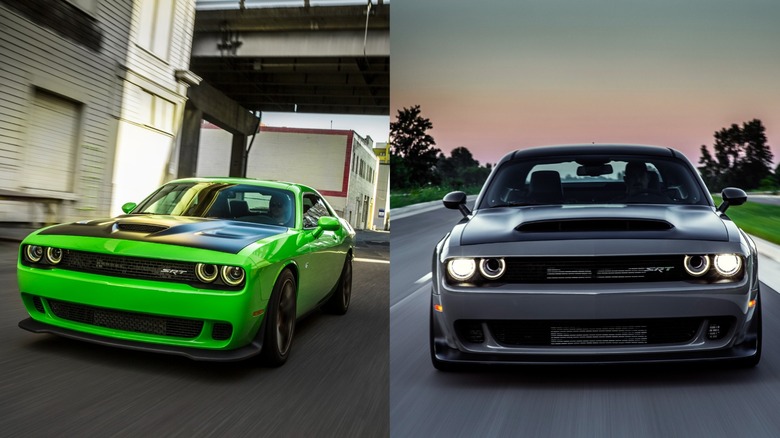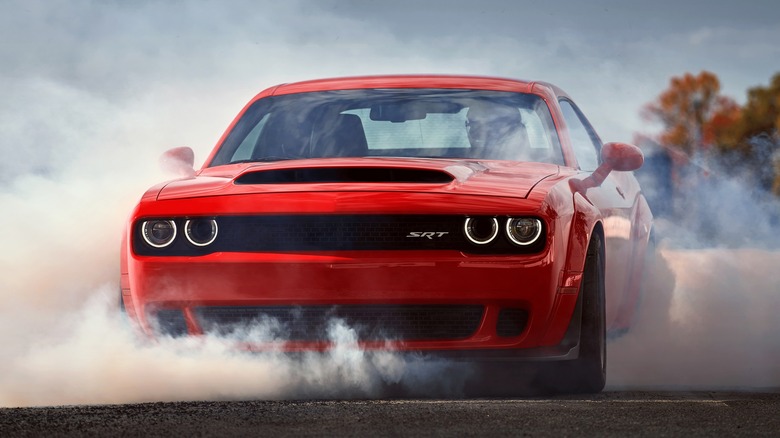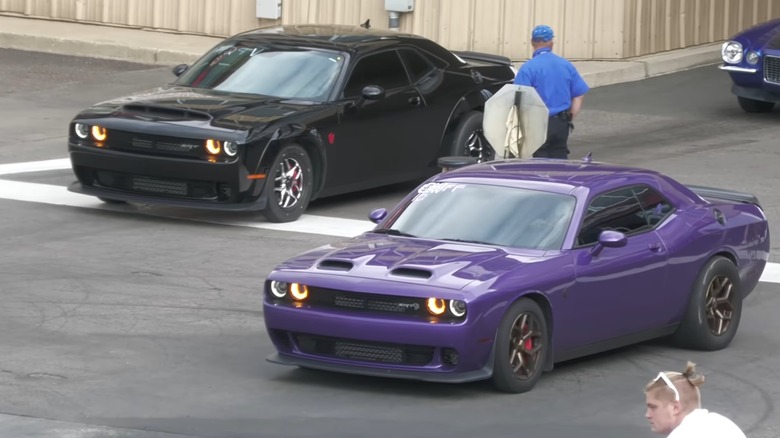Hellcat Vs. Demon: What's The Difference Between These Dodge Challenger Models?
Few legendary muscle cars are remembered and celebrated like the Dodge Challenger. With the first model debuting in 1969, you could get a brand-new R/T model for just $3,266 at the time. Fast forward to the late 2000s and this muscle car was returning to form, but it wasn't until 2015 that Dodge really started upping the ante.
The Challenger SRT Hellcat became the most potent muscle car to date at its 2015 launch, with 707 horsepower and 650 lb-ft of torque. But in 2018, the automaker would create another variation of the Challenger called the Demon. Fortunately for performance fans, the original version of this car didn't come to fruition, as the 2007 Dodge Demon concept was the American Miata that never was. The 2018 muscle car, on the other hand, was aptly named, with 840 horsepower and 770 lb-ft of torque. These two muscle cars featured some of the most powerful engines put in the Challenger. Besides horsepower and torque figures separating the Hellcat and Demon, there were also differences in the exterior, acceleration, cooling, and launch modes.
Hood scoop and factory transbrake system
The Hellcat was made for those who wanted a ridiculous amount of brawn under the hood, appealing to the same crowd that loves the classic muscle car era. Between 2015 and 2019, Dodge would sell 11,995 units, per TheDrive.com. The Demon was made specifically for the drag strip and included several track upgrades that made it feel and perform differently. First, while the Hellcat does feature a special port that funnels air into the engine, the Demon has an additional side scoop and the largest working hood scoop ever included on a mass-produced car at 45.2 square inches. The massive Air-Grabber forced induction technology included with the Demon gives it an edge over the Hellcat in both throttle and acceleration off the line.
The Dodge Challenger Demon, in keeping with its goal to dominate on the quarter mile, also includes a transbrake, which is not available in the Hellcat. Transbrakes are used on the dragstrip for the most optimum launch off the line. Essentially, this add-on enables the driver to focus on applying the gas pedal without needing to mash down the brakes simultaneously. It also applies full throttle to the car the moment the transbrake is disengaged.
SRT Power Chiller and Drag Mode Launch Assist
While the Hellcat remains an impressive performance machine, it doesn't include the racetrack extras the automaker installed into the Demon. Engineers at the automaker designed the SRT Power Chiller system specifically for the Demon, which takes the cooling power of the air conditioning and lowers the temperature of the air entering the supercharger. The chilled air enables more horsepower than if the intake was hot. Like the transbrake, the SRT Power Chiller is another first in terms of racing modifications installed at the factory.
While the Hellcat does feature a launch mode which allows you to get a better jump off the line, the Demon comes with a special Drag Mode. This unique launch option, not available in any other production car, monitors the wheels and can adjust torque if slipping occurs. The Demon's power causes the wheels to actually hop when accelerating off the starting line, which can cause damage; as such, the Drag Mode Launch Assist helps prevent this issue. All these performance additions were so effective that the Dodge Challenger SRT Demon got banned by the NHRA.


